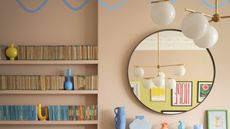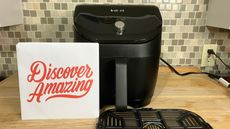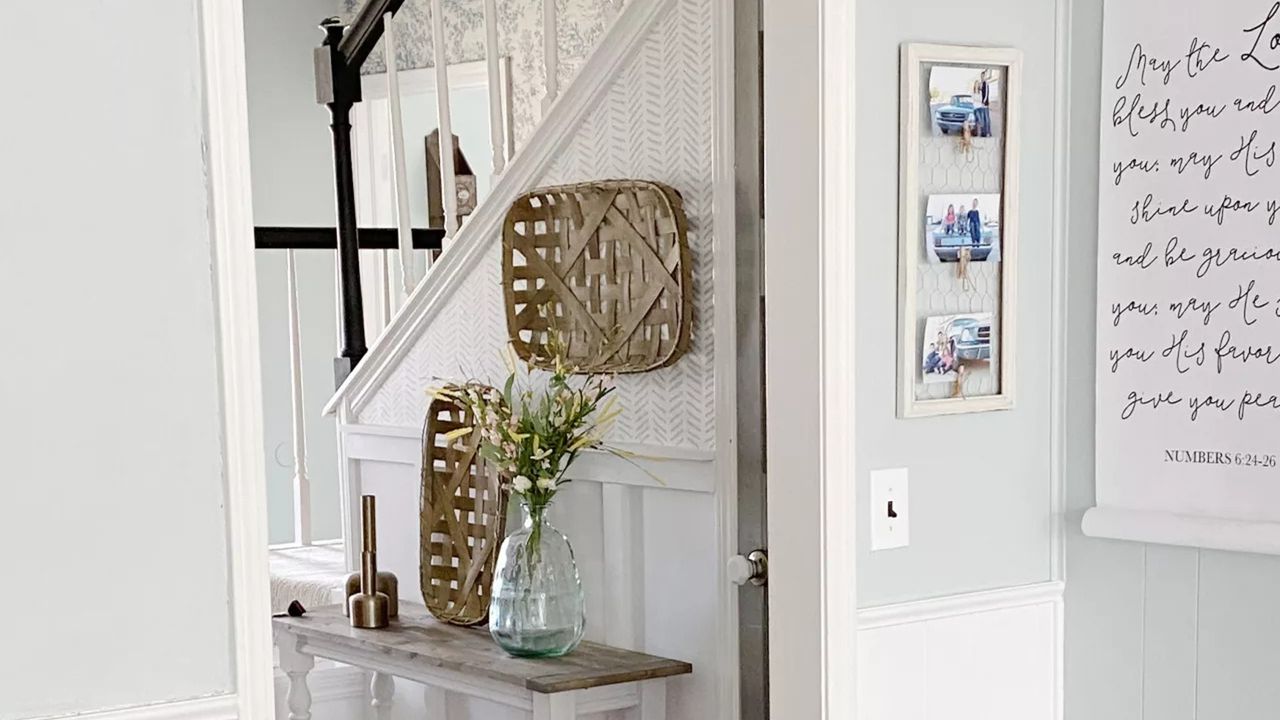

Good first impressions are important, and everyone wants to make a good impression when you welcome people to your home! Sure, your entryway is the perfect place to stash steam cleaners and vacuums – but it's important for it to be pretty and tidy, as it's the first thing guests see when they walk into your house, and it can set the stage for the rest of the feel of your home. Here, Dori Turner explains how she transformed hers.
Our entryway was very clean looking, but very boring. We had given the walls and trim a fresh coat of paint when we first moved in, but it had remained largely untouched since then. We’ve done a ton of work to the rest of the lower level of the house, but you couldn’t tell when you first walked in the door. So, I decided it was time for a change and that a bit of an accent wall would be the perfect way to add interest to this spot.
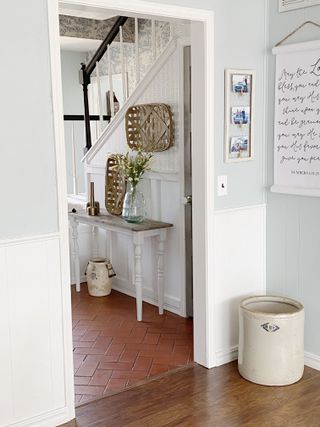
The entryway wall before adding freehand wall stencilling:
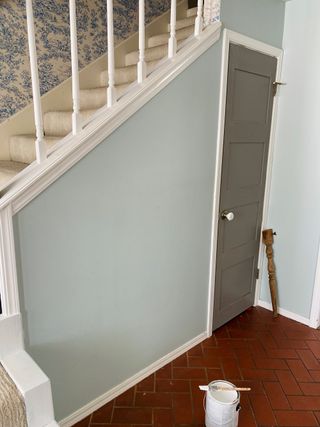
The first step was to add some board and batten. I love how it turned out, but the rest of the wall still seemed a little plain. I went back and forth between adding wallpaper or doing a stencil.
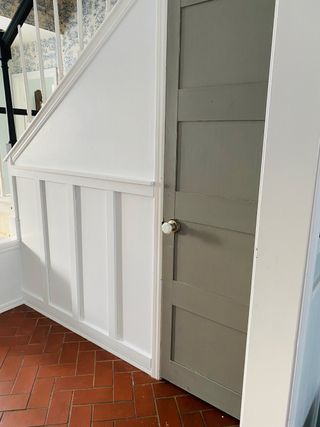
In the end, I decided to do my own DIY stencil wall mimicking a pattern I had seen available online. The lines in the pattern weren’t perfectly straight and it almost resembled a broken herringbone design because the lines didn’t connect – but there’s beauty in imperfection sometimes, don’t you think? Plus, it gave me more confidence that I could replicate the pattern using my own materials I already had on hand! It felt like a really unique way to personalize our entryway – without spending tons of cash.
Here are the supplies I used for this DIY project:
- ¾” electrical tape
- Ruler
- Pencil
- Detail artist paint brush
- White interior paint (satin finish)
- Gray interior paint (satin finish)
1. Freshen up the walls
I started by painting the walls with two fresh coats of paint. The rest of our entryway is a bluish gray, but I chose to go white on this wall to create more of a focal point. I chose gray paint for the lines. You can definitely choose whatever entryway or hallway paint colors work best for your home!
2. Mark up the wall for stenciling
Once the paint was completely dry (you don’t want the wall to be even a little sticky, or the tape will remove the finish), I found the center of the wall and used a pencil and ruler, marking off every 5 inches vertically down the wall. The marks helped me line up the electrical tape in a straight line. You want to start in the center of the wall so the pattern works out to be equal on both ends. The center of my wall was in an awkward place because of the closet door, but we made it work.
Take a look at Real Homes' guide to how to paint trim and molding for beginners.
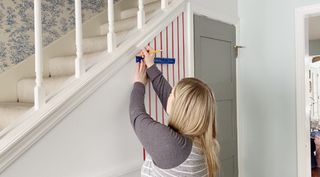
3. Finish lining the entire wall
Once you’ve made your first vertical line with the tape, decide how far apart you want the next line to be. The closer the next piece of tape, the shorter the gray lines will be. The further away, the longer the gray lines will be. It’s completely up to you and the look you’re going for! I chose to place my next piece of tape 2 inches away from the center piece.
You will repeat this process on both sides of the center piece of tape until you have lined the entire wall. This could be a tedious process if you’re looking to do a large wall, but for my small entryway wall, it was perfect!
4. Start painting the diagonal lines
Once your tape is in place, you’re ready to begin making the diagonal lines. Starting in the center of the wall again and at the top, take your artist brush and contrasting paint, and begin freehanding your slants. For this part, I chose not to measure. I just eyeballed the distance between the diagonal lines and every so often stepped back to make sure the distance apart was relatively the same.
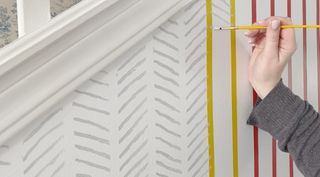
5. Move onto the next section and finish up
Once you’ve finished your first section of diagonal lines, you’re ready to begin on the next section. This time you’ll do your lines in the opposite direction of the first section, roughly matching up the starting point of each line with those on the previous section. Repeat this process in each section until the wall is complete.
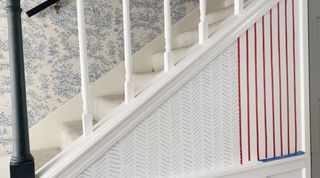
Carefully peel off each piece of electrical tape, then step back and enjoy your beautiful DIY stencil wall!
The results: after adding freehand wall stencilling
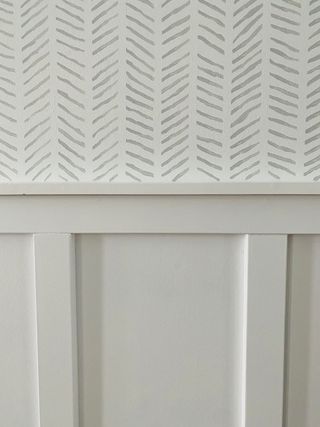
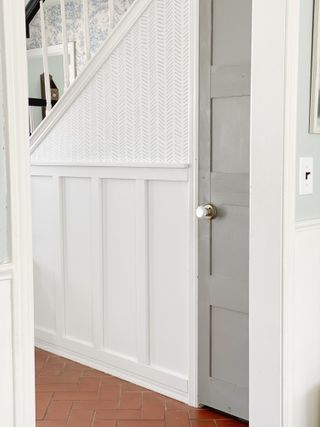
This project was easy and inexpensive since I had most of the supplies already on hand! It only took an afternoon of my time to complete it and I’m thrilled with the results – it's one of the best staircase ideas if you're looking to add some interest to your hallway. We added a table my husband built specifically for that space and, after adding some decor, our entryway is now a welcoming hub for our guests! It makes a great first impression and ties everything together for a cohesive look throughout our home.
Join our newsletter
Get small space home decor ideas, celeb inspiration, DIY tips and more, straight to your inbox!
Dori Turner writes blog posts and feature articles on affordable design and DIY from her home in the heart of Oklahoma. She has a passion for teaching others how they can transform their home on a budget.
-
 What is color drenching? Interior designers love this bold trend
What is color drenching? Interior designers love this bold trendIf you're curious about color drenching, our interior designers explain what it is, how to do it, and what to shop to bring it into your home
By Sophie Warren-Smith Published
-
 7 spring home decor ideas to refresh your home for the season
7 spring home decor ideas to refresh your home for the seasonThese spring home decor ideas from interior designers are perfect for brightening up any dull apartment or living space for the new season ahead
By Eve Smallman Published
-
 How to hang a wreath on a door (without damaging it)
How to hang a wreath on a door (without damaging it)Hang a wreath on a door or mantel without damaging it with our simple tips and tricks. Use some ribbon or adhesive hooks to to pretty up your pad
By Niamh Quinn Last updated
-
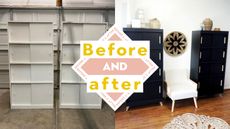 Before & After: 2 basic bookcases get a modern makeover
Before & After: 2 basic bookcases get a modern makeoverTalented furniture flipper shares how to refinish a cheap basic bookcase and turn it into a modern piece, sure to turn heads.
By Camille Dubuis-Welch Published
-
 How to hang pictures and fill wall space with art
How to hang pictures and fill wall space with artKnowing how to hang pictures on the wall, with or without nails, will let you decorate your space with art and stunning prints in no time.
By Camille Dubuis-Welch Published
-
 How to dry flowers: 4 simple ways to preserve blooms
How to dry flowers: 4 simple ways to preserve bloomsTired of throwing away a bunch of beautiful blooms? Learn how to dry flowers so they last forever
By Sophie Warren-Smith Last updated
-
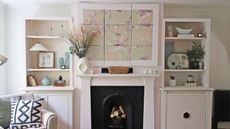 How to hide a TV on the wall: a DIY disguise with art
How to hide a TV on the wall: a DIY disguise with artDIY a disguise for your TV on the wall with art and turn heads in your front room, for all the right reasons
By Claire Douglas Published
-
 How to measure for curtains: a DIY guide for beautifully-dressed windows
How to measure for curtains: a DIY guide for beautifully-dressed windowsLearning how to measure curtains correctly involves working out the ideal dimensions. Here, we drop it like it's hot
By Emily Shaw Published
